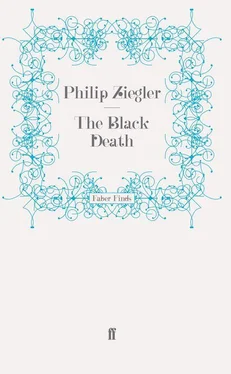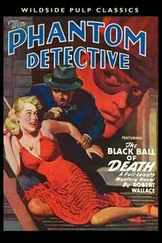The Jews were not the only candidates as victims. In large areas of Spain the Arabs were suspected of playing some part in the propagation of the plague. All over Europe pilgrims were viewed with the gravest doubts; in June 1348 a party of Portuguese pilgrims were said to be poisoning wells in Aragon and had to be given a safe conduct to get them home. {177} 177 26 A. Lopez de Meneses, ‘Documentos acerca de la Peste Negra en los dominion de la Corona de Aragon’, Consejo Superior de Investigaciones Cientificas, Vol. VI, 1956, p. 301.
In Narbonne it was the English who were at one time accused. {178} 178 27 G. Sticker, Die Geschichte der Pest, op. cit., p. 59.
But it was the leper who most nearly rivalled the Jew as popular scapegoat. The malign intentions of the leper had long been suspected by his more fortunate fellows. In 1346 Edward III declared that lepers were no longer to enter the City of London since:
…some of them, endeavouring to contaminate others with that abominable blemish (that so, to their own wretched solace, they may have the more fellows in suffering) as well in the way of mutual communication, and by the contagion of their polluted breath, as by carnal intercourse with women in stews and other secret places, detestably frequenting the same, do so taint persons who are sound, both male and female, to the great injury of the people dwelling in the city…
But it is one thing to try to infect others with one’s own disease for the sake of the extra companionship, another to spread the plague out of sheer devilry. When in Languedoc, in 1321, all the lepers were burnt on suspicion of poisoning wells, it was claimed that they had been bribed to do so by the Jews who, in their turn, were in the pay of the King of Granada. {179} 179 28 Lea, op. cit., Vol. II, p. 380.
There were one or two cases, notably in Spain, where lepers suffered during the Black Death on suspicion of complicity but there do not seem to be any where the Jews were not accorded the leading role and the lepers cast as the mere instruments of their wickedness.
One reason for this was that nobody had cause for envying the lepers or economic reason for wishing them out of the way. It was very different with the Jews whose popular image was that of the Prioress’s Tale:
…sustened by a lord of that contree
For foule usure and lucre of vileynye,
Hateful to Christ and to his compaignye. [3] …supported by the Crown For the foul lucre of their usury, Hateful to Christ and all his company.
In Germany, and to some extent also in France and Spain, the Jews provided the money-lending class in virtually every city – not so much by their own volition as because they had been progressively barred from all civil and military functions, from owning land or working as artisans. Usury was the only field of economic activity left open to them; an open field, in theory at least, since it was forbidden to the Christian by Canon Law. In cities such as Strasbourg they flourished exceedingly and profited more than most during the economic expansion of the thirteenth century. {180} 180 29 H. Dubled, ‘Aspects économiques de la vie de Strasbourg aux XIH e et XIV e siècles’, Archives de l’Église d ’ Alsace, N.S., Tome VI, 1955, pp. 23–56.
But the recession of the fourteenth century reduced their prosperity and the increasing role played by the Christian financiers, in particular the Italian bankers, took away from them the cream of the market. In much of Europe the Jew dwindled to a small money-lender and pawnbroker. He acquired a large clientele of petty debtors so that every day more people had cause to wish him out of the way. ‘It can be taken for granted,’ wrote Dr Cohn, ‘that the Jewish money lenders often reacted to insecurity and persecution by deploying a ruthlessness of their own.’ {181} 181 30 N. Cohn, Pursuit of the Millenium, London, 1957, p. 124.
It is fair to criticize the medieval Jews for exacting exorbitant rates of interest from their victims but it is also only fair to remember the extreme precariousness of their business, dependent on the uncertain protection of the local ruler and with virtually no sanctions at their disposal to enable them to recover their money from a reluctant debtor. To ensure their own safety the luckless Jews were forced to pay ever larger bribes to the authorities and, to raise the money for the bribes, they had to charge higher interest and press their clients still more harshly. Animosity built up and, by the middle of the fourteenth century, Shylock had been born. The Jew had become a figure so hated in European society that almost anything might have served to provoke catastrophe.
But though the economic causes for the persecution of the Jews were certainly important it would be wrong to present them as the only, or even as the principal reason for what now happened. The Jew’s role as money-lender predisposed many people to believe any evil which they might hear of him but the belief itself was sincere and had far deeper roots. The image of the Jew as Antichrist was common currency in the Middle Ages. It seems to have gained force at the time of the First Crusade and the Catholic Church must accept much of the responsibility for its propagation. The vague enormity of such a concept was quickly translated into terms more comprehensible to the masses. In particular the more irresponsible priests spread rumours that the Jews kidnapped and tortured Christian children and desecrated the host. They were represented as demons attendant on Satan, portrayed in drama or in pictures as devils with the beards and horns of a goat, passing their time with pigs, frogs, worms, snakes, scorpions and the horned beasts of the field. Even the lay authorities seemed intent on fostering public belief in the malevolence of the Jews; in 1267, for instance, the Council of Vienna forbade purchases of meat from Jews on the ground that it was likely to be poisoned.
Today such fantasies seem ludicrous. It is hard to believe that sane men can have accepted them. And yet Dr Norman Cohn {182} 182 31 Ibid, p. 387.
has drawn a revealing parallel between anti-Semitism in the fourteenth century and under the Third Reich. On 1 May 1934 Der Stürmer devoted a whole issue to alleged murders of Christian children by the Jews; illustrating its text with pictures of rabbis sucking blood from an Aryan child. Most Germans were no doubt revolted by such vicious propaganda but Buchenwald, Auschwitz and Belsen live vividly enough in the memory to save this generation from any offensive sense of superiority to its ancestors. Nor do the still more recent Chinese accusations that American airmen, in 1952, showered the countryside around Kan-Nan Hsien with voles infected with Pasteurella pestis, the bacillus of bubonic plague, suggest that man’s infinite capacity for thinking ill of man is in any way on the wane. {183} 183 32 Ilza Veith, ‘Plague and Polities’, Bull. Hist Med., Vol. XXVIII, 1954, p. 409.
The Black Death concentrated this latent fear and hatred of the Jews into one burning grievance which not only demanded vengeance but offered the tempting extra dividend that, if the Jews could only be eliminated, then the plague for which they were responsible might vanish too. There was really only one charge levelled against the Jews; that, by poisoning the wells of Christian communities, they infected the inhabitants with the plague. The Polish historian, Dlugoss, claimed that they also poisoned the air {184} 184 33 cit. Hecker, p. 38.
but this view does not seem to have been at all widely shared. Some of the more fanciful reports alleged that the Jews were working under the orders of a conspiratorial network with its headquarters in Toledo; that the poison, in powdered form, was imported in bulk from the Orient, and that the same organization also occupied itself in forging currencies and murdering Christian children. But these were decorative frills, the attack on the sources of drinking water was the central issue.
Читать дальше












